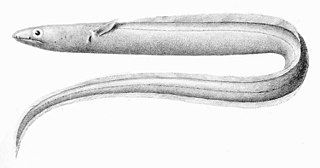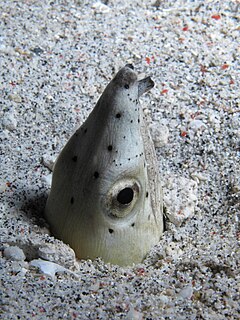Related Research Articles

Echelus is a genus of eels in the snake-eel family Ophichthidae.

Ophichthus is a genus of eels in the snake eel family Ophichthidae.

The highfin snake eel (Ophichthus altipennis, also known as the blackfin snake eel or the black-finned snake eel, is an eel in the family Ophichthidae. It was described by Johann Jakob Kaup in 1856, originally under the genus Microdonophis. It is a marine, tropical eel known from the eastern Indian Ocean and northwestern and western central Pacific Ocean, including Australia, French Polynesia, Indonesia, Japan, the Marshall Islands, Malaysia, the Philippines, and Papua New Guinea. It dwells at a depth range of 0 to 40 m, and forms burrows in soft inshore sand sediments. Males can reach a maximum total length of 103 cm.
Ophichthus aniptocheilos is an eel in the family Ophichthidae. It was described by John E. McCosker in 2010. It is a marine, deep water-dwelling eel known from Tonga, in the eastern central Pacific Ocean. It dwells at a depth range of 391 to 421 m. Males can reach a maximum total length of 14.2 cm (5.6 in).
The thin snake eel is an eel in the family Ophichthidae. It was described by John E. McCosker and Richard Heinrich Rosenblatt in 1998. It is a marine, tropical eel known from the eastern central and southeastern Pacific Ocean, including Mexico and Colombia. It is known from two specimens observed dwelling in sand at a depth range of 0 to 8 m. The maximum length recorded was 23.1 cm (9.1 in), albeit on an immature specimen.
The dark deepwater snake-eel is an eel in the family Ophichthidae. It was described by John E. McCosker and Chen Yu-Yun in 2000. It is a marine, deep water-dwelling eel which is known from Taiwan, in the northwestern Pacific Ocean. It dwells at a depth range of 36–1350 m, and inhabits sand and mud. Specimens have been observed in burrows with only their heads exposed, or resting on sediment with their bodies curved in an S shape. Females can reach a maximum total length of 62.8 cm.
The snubnose snake eel is an eel in the family Ophichthidae. It was described by John E. McCosker and Steve W. Ross in 2007. It is a marine, subtropical eel which is known from North Carolina, USA, in the western central Atlantic Ocean. It dwells at a depth range of 370 to 440 meters. Females can reach a total length of 29.2 centimeters (11.5 in).
Ophichthus exourus is an eel in the family Ophichthidae. It was described by John E. McCosker in 1999. It is a marine, deep water-dwelling eel which is known from New Caledonia and Fiji, in the western Pacific Ocean. It dwells at a depth range of 400 to 520 metres. Males can reach a maximum total length of 66.9 centimetres (26.3 in), while females can reach a maximum TL of 59 centimetres (23 in).
Ophichthus hirritus is an eel in the family Ophichthidae. It was described by John E. McCosker in 2010. It is a marine, deep water-dwelling eel which is known from the Seychelles Islands, in the western Indian Ocean. It is known to dwell at a depth of 600 metres (2,000 ft). Males can reach a maximum total length of 52.8 centimetres (20.8 in), while females can reach a maximum TL of 53.4 centimetres (21.0 in).
Ophichthus humanni is an eel in the family Ophichthidae. It was described by John E. McCosker in 2010. It is a marine, deep water-dwelling eel which is known from Vanuatu, in the western Pacific Ocean. It dwells at a depth range of 254 to 300 metres. Males can reach a maximum total length of 66.9 centimetres (26.3 in).
The Faintsaddled snake eel is an eel in the family Ophichthidae. It was described by John E. McCosker and Eugenia Brandt Böhlke in 1984. It is a marine, temperate water-dwelling eel which is known from the western central Atlantic Ocean. It is known to dwell at a depth of 108 meters.
Ophichthus ishiyamorum is an eel in the family Ophichthidae. It was described by John E. McCosker in 2010. It is a marine, deep water-dwelling eel which is known from the Gulf of Aden and Somalia. It dwells at a depth range of 258 to 400 metres. Males can reach a maximum total length of 43.7 centimetres (17.2 in).
Ophichthus lentiginosus is an eel in the family Ophichthidae. It was described by John E. McCosker in 2010. It is a marine, deep water-dwelling eel which is known from Vanuatu and New Caledonia, in the western central Pacific Ocean. It is known to dwell at a depth of 400 metres (1,300 ft). Males can reach a maximum total length of 62.8 centimetres (24.7 in), while females can reach a maximum TL of 56.3 centimetres (22.2 in).
Ophichthus longipenis, known commonly as the Slender snake eel in Mexico, is an eel in the family Ophichthidae. It was described by John E. McCosker and Richard Heinrich Rosenblatt in 1998. It is a marine, tropical eel which is known from the eastern central Pacific Ocean, including Mexico, El Salvador, Guatemala, Honduras, Nicaragua, Costa Rica and Panama. It dwells at a depth range of 0 to 69 metres, and inhabits sand sediments. Males can reach a maximum total length of 58.7 centimetres (23.1 in).
The Longarmed snake eel is an eel in the family Ophichthidae. It was described by John E. McCosker and Richard Heinrich Rosenblatt in 1998. It is a marine, tropical eel which is known from the eastern central Pacific Ocean, including Mexico, Costa Rica, El Salvador, Guatemala, Nicaragua, and Panama. It is known to dwell at a depth range of 24 to 79 metres, and inhabits soft substrates. Males can reach a maximum total length of 27.4 centimetres (10.8 in).
Ophichthus melope is an eel in the family Ophichthidae. It was described by John E. McCosker and Richard Heinrich Rosenblatt in 1998. It is a marine, tropical eel which is known from the eastern central and southeastern Pacific Ocean, including Colombia and Costa Rica. It dwells at a depth range of 100 to 224 metres. Males can reach a maximum total length of 27 centimetres (11 in).
Ophichthus menezesi is an eel in the family Ophichthidae. It was described by John E. McCosker and Eugenia Brandt Böhlke in 1984. It is a marine, temperate water-dwelling eel which is known from the southwestern Atlantic Ocean. It is known to dwell at a depth of 177 meters (581 ft).
Ophichthus microstictus is an eel in the family Ophichthidae. It was described by John E. McCosker in 2010. It is a marine, deep water-dwelling eel which is known from the western central Pacific Ocean, including Tonga, Fiji, and New Caledonia. It dwells at a depth range of 362 to 450 metres. Males can reach a maximum total length of 48.9 centimetres (19.3 in).
The dottedline snake eel is a species of eels in the family Ophichthidae. It was described by John E. McCosker and Eugenia Brandt Böhlke in 1984. It is a marine, temperate water-dwelling eel which is known from the western central Atlantic Ocean. It is known to dwell at a depth of 183 meters.
Ophichthus tomioi is an eel in the family Ophichthidae. It was described by John E. McCosker in 2010. It is a marine, deep water-dwelling eel which is known from the Indo-Pacific, including the Philippines, the Seychelles Islands, Marquesas, and Fiji. It dwells at a depth range of 300 to 423 metres. Males can reach a maximum total length of 44.7 centimetres (17.6 in).
References
- 1 2 3 Ophichthus pullus at www.fishbase.org.
- ↑ McCosker, J. E., 2005 (30 Dec.) [ref. 28646] A new species of deepwater snake eel, Ophichthus pullus (Anguilliformes: Ophichthidae) from Angola and Guinea-Bissau. Proceedings of the California Academy of Sciences (Series 4) v. 56 (no. 36): 669-674.